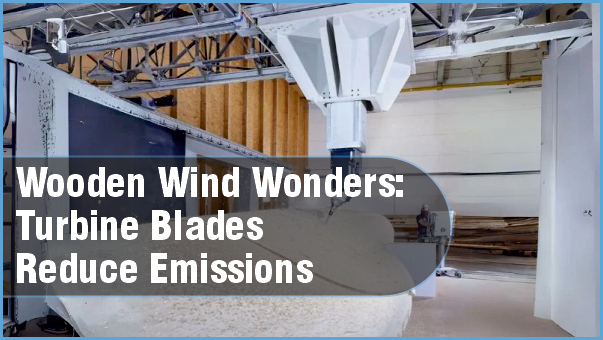Wooden Wind Wonders: Turbine Blades Reduce Emissions
The laminated blades reduce carbon dioxide emissions and production costs, marking a significant step toward sustainable wind energy.
Wind turbine blade disposal presents significant environmental concerns. Finding innovative and cost-effective methods for recycling wind turbine blades is essential in mitigating wind energy’s environmental impact and ensuring long-term sustainability.
A German turbine glade manufacturer hopes to address the recycling dilemma with biodegradable wood blades. Voodin Blade Technology has installed a prototype of its wooden wind blades on a turbine near Kassel, Germany. The blades cost less and have a lower carbon footprint than conventional blades.

Wooden blade manufacturing. Image used courtesy of Voodin Blade Technology
Is Wind Energy Truly Green?
Wind turbines capture wind kinetic energy and transform it into mechanical energy to produce electricity. This electricity generation method is renewable and environmentally friendly, emitting no harmful emissions. However, the industry must address wind energy’s end-of-life impact, including waste and emissions, for true sustainability. Up to 90% of wind turbines are recyclable, but the blades remain non-recyclable.
The turbine blades’ fiberglass-based composition poses recycling challenges because the material is non-biodegradable and includes plastic and glass. Recycling composites like fiberglass is inherently difficult, requiring separating different components. Specifically, wind turbine blades contain thermoset resins like epoxies, polyesters, and vinyl esters, which form strong cross-linked polymers during curing, complicating recycling further. Consequently, most blades end up in landfills or incinerated.
The recycling issue is significant and expanding, with 1.5 million metric tons of decommissioned blades expected in the U.S. by 2040. With an annual retirement rate of 3,000 to 9,000 blades, the number is projected to rise rapidly. The typical blade lifespan ranges from 20 to 25 years. As the initial generation of blades nears the end of its operational lifespan, there is a growing need for environmentally sustainable solutions to guarantee the long-term viability of wind energy production.
Green Energy Milestone
Voodin Blade Technology aims to address the sustainability challenge by installing wooden wind turbine blades in Breuna, Germany.

Voodin wind blade. Image used courtesy of Voodin Blade Technology
These 19.3-meter blades, made of laminated veneer lumber (LVL), can reduce carbon dioxide emissions by up to 78% and decrease production costs by 20%. LVL is a durable engineered wood product formed by bonding veneers under heat and pressure. This wood enables better recycling of decommissioned blades. It offers a high level of automation that conventional materials cannot achieve because wood is a significantly more sustainable raw material than composite materials.

Estimates of wooden blade benefits. Image used courtesy of Voodin Blade Technology
Moreover, by enhancing automation in blade manufacturing, the demand for labor decreases, enabling manufacturing closer to wind farms. This reduces transportation costs and emissions, as production no longer relies on countries with lower labor costs.
Voodin’s approach includes CNC milling machines for complex 3D shaping without molds, increasing automation and flexibility in manufacturing. This technology ensures durability, with extensive laboratory testing proving the blades’ endurance in onshore wind conditions, making them even more robust than fiberglass alternatives.
Leading the Charge
Through rigorous laboratory testing, Voodin Blade Technology has ensured that its material excels in the demanding conditions of onshore wind energy production. Their blades are more durable than fiberglass blades, showing fewer fatigue characteristics and proven resilience to various onshore weather conditions. The company is now developing larger prototypes, including 60-meter and 80-meter blades, as the next project phase.

